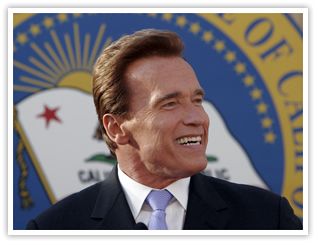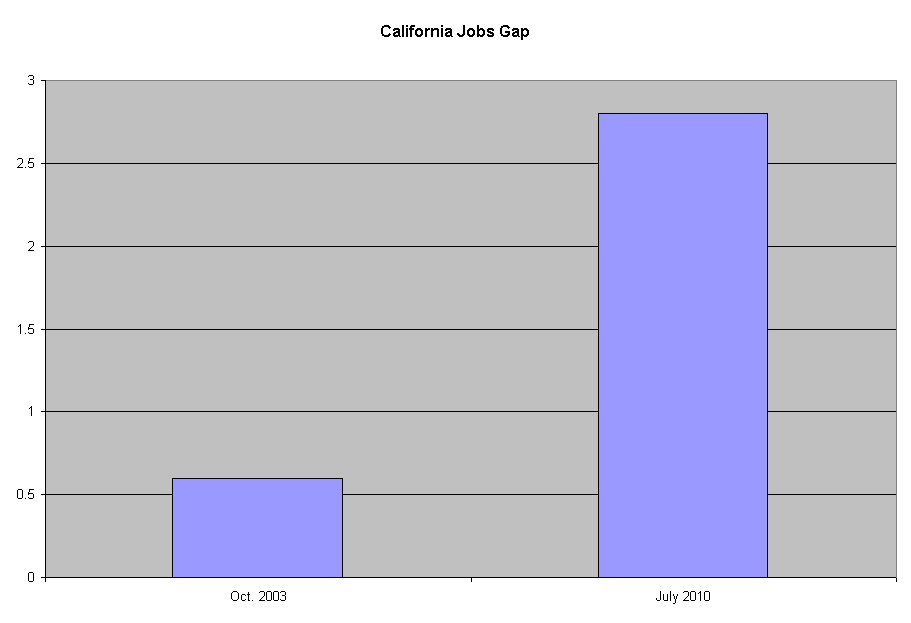Arnold's seven wasted years
SEPT. 7, 2010
By JOHN SEILER
With Labor Day marking the traditional beginning of the campaign season, Gov. Arnold Schwarzenegger’s seven years as governor of California essentially are behind us. He will still have influence on the fiscal 2010-10 state budget, now almost three months behind its constitutional deadline for passage of June 15.
It’s also possible the budget could go un-passed, handed off to his successor. But even if a budget is passed, it already will be obsolete when the next governor takes office in January.
As a cautionary note to the voters and the next governor, it’s worth examining why Arnold, whose governorship began with uplifting hopes of “terminating” the state deficit and “blowing up the boxes” of state waste, fraud and abuse, went so wrong.
I’ll begin with some comparisons of California in September 2010 to California in September 2003, on the eve of the historic recall that ousted failed Democratic Gov. Joseph Graham “Gray” Davis and put in power Republican Gov. Arnold Alois Schwarzenegger.
Gray vs. Arnold
In 2003, California was recovering from the dot-com boom/bust that lingered here in California longer than in most places. Today, of course, we’re suffering from the Great Recession, a much worse economy, the worst since the Great Depression. America possibly is headed into the second “dip” of a double-dip recession.
In July 2010, the last month available, California unemployment stood at 12.3 percent, nearly double the 6.6 percent of October 2003, Davis’ last month in office.
But we can’t blame Arnold for all that increase. He had almost nothing to do with the national policies that brought about today’s slump.
But earlier this year I devised what I called the “Jobs Gap,” which compares California’s unemployment with that of the nation, thus mostly factoring out national policies. It’s calculated by subtracting the national unemployment rate from the state rate.
In October 2003, the month Davis was recalled, the U.S. unemployment rate was 6.0 percent; today it’s 9.5 percent for July 2010.
We combine the two numbers to get the Jobs Gap. In October 2003, California unemployment was 6.6 percent and U.S. unemployment 6.0 percent, for a Jobs Gap of 0.6 percent. While in July 2010, California unemployment was 12.3 percent and U.S. unemployment 9.5 percent, for a Jobs Gap of 2.8 percent.
So, the Jobs Gap rose from 0.6 percent under Gray Davis to 2.8 percent under Schwarzenegger, an increase of 367 percent.
However you look at it, this is a dismal achievement. It’s true that the housing bust hit California especially hard. But it also hit Arizona, which in July 2010 had an unemployment of 9.6 percent. Its Jobs Gap is just 0.1 percent.
And Schwarzenegger himself pushed assistance programs to get low-income people into low-income housing. Even in September 2007, as the housing bust was accelerating, he was lobbying Congress for even more easy, taxpayer-backed loans to low-income people — the very same folly that magnified the housing boom/bust.
Low-income people should be renting. When they take out $600,000 home loans, as thousands did during the height of the real-estate mania in the mid-2000s, the only result can be disaster.
Budget deficit
When Schwarzenegger replaced Davis, the state budget deficit widely was reported as $38 billion. But as Spinsanity noted at that the time, the number was exaggerated:
Whatever one’s view of the budget deal, the $38 billion deficit no longer existed once the legislation was signed, and the relevant state budget figure became a projected $8 billion deficit for 2004-2005.
However, politicians and pundits, either through ignorance or intentional exploitation of voter confusion, routinely repeated the $38 billion figure. Schwarzenegger made a number of references to the $38 billion deficit in the present tense, as if it still existed. For example, on August 7, a week after the budget deal, he said, “We have a $38 billion budget deficit that we have to deal with.”
By contrast, the current deficit under Gov. Schwarzenegger for the un-passed fiscal 2010-11 is $19 billion. So, during his term in office, the governor has doubled the deficit he inherited from Davis.
Electricity crisis
One of the main reasons Davis was recalled was because he panicked during the electricity crisis of 2000-01, which led to widespread blackouts across the state. He signed long-term deals for electricity that, it turned out, were far above market rates. As Greg Lucas noted earlier this year:
California’s energy crisis in the winter of 2000 — spot market prices hit $2,000 per megawatt hour — may seem like a thing of the past for electricity customers. It’s not.
They’re still paying the price: About $3 billion each year for the next three years.
Of the 58 contracts the state Department of Water Resources negotiated in 2001 and 2002 at a cost of $42.5 billion, 26 still exist with an estimated portfolio cost of $9.8 billion between now and 2015 when the final two contracts expire.
Customers of utilities like Southern California Edison and Pacific Gas & Electric pay those costs.
Schwarzenegger didn’t face an electricity crisis. And this summer, California weather has been unusually cool. So, although the governor wants to be remembered for AB 32, the Global Warming Solutions Act of 2006, he closes out his tenure in office with a light electricity load due to statewide cooling.
Tax increases
One reason Davis was booted from office was his unilateral tripling of the car tax, raising taxes on Californians by $4.2 billion. Schwarzenegger pledged to repeal the tax increase, and did so quickly after winning office.
But in February 2009, Schwarzenegger increased taxes a record $13 billion, more than three times Davis’ tax increase.
Missed opportunities
“Schwarzenegger didn’t address the fundamental problems that this state was facing in 2003 and later,” Esmael Adibi told me; he’s Director of the A. Gary Anderson Center for Economic Research and Anderson Chair of Economic Analysis and a member of the state controller’s Council of Economic Advisors.
“The whole premise he came in with was that he was going to get rid of the huge budget deficit. But the first thing he did was float that $15 billion bond.” According to Ballotpedia, in 2004, “Proposition 57 authorized the state to sell $15,000,000,000 in long-term bonds to pay off accumulated deficits.”
Prop. 57 “didn’t address the more fundamental problem of overspending,” Adibi said. The economy was in bad shape in 2003, he said, and there was a window of opportunity to pass a reform measure. Instead, after Prop. 57 passed, the opportunity was missed.
Soon, the national economy took off, and with it California. With revenues pouring in, the deficits vanished and the need for reform seemed to be over.
In 2005, Adibi remembered, the governor backed the reform plank of four ballot initiatives on the November ballot. One was Proposition 76, which Ballotpedia explained, “Had it passed, it would have limited state spending and changed the minimum requirements for public school funding.” It didn’t pass.
“He picked a fight with all the unions” over the reform initiatives, Adibi said. “He should have done that during his honeymoon with the state after the election. He lost the battle. And with that much of his credibility.”
Unfinished business
Schwarzenegger leaves to his successor three huge problems, Adibi warned:
1. A huge structural deficit, currently $19 billion.
2. Unfunded pensions and health care costs for retired government workers.
3. A large increase in regulations, such as AB 32, and taxation.
“I hope the next governor won’t make the same mistakes as Schwarzenegger, of putting Band-Aids on problems,” Adibi warned. “Then the economy gets worse, and we face multiple years of deficits.”
Schwarzenegger took up the pension crisis in an Aug. 27 op-ed in the Wall Street Journal. He wrote:
Recently some critics have accused me of bullying state employees. Headlines in California papers this month have been screaming “Gov assails state workers” and “Schwarzenegger threatens state workers.”
I’m doing no such thing. State employees are hard-working and valuable contributors to our society. But here’s the plain truth: California simply cannot solve its budgetary problems without addressing government-employee compensation and benefits.
As usual, he turned the situation to himself and his ego. And he was seven years late.
Morphing into Davis
“It’s one of those great cycles of history,” Jack Pitney told me of Arnold becoming like Davis; Pitney is a professor of American politics at Claremont McKenna College. “We’ve come full circle. The Terminator is morphing back into Davis. ‘Terminator 2‘ popularized the term ‘morphing’.”
As to the recall, Pitney said Schwarzenegger’s failure “doesn’t necessarily invalidate the process. but you can’t always assume that a recall will have a happy ending.”
John Seiler, an editorial writer with The Orange County Register for 20 years, is a reporter and analyst for CalWatchDog.com. His email: [email protected].
Related Articles
Meg sticker sighted!
I just saw the first car bumper sticker of the 2010 election season. It read “Meg 2010” and was pasted
CA and Obamacare: Media offer happy talk, not analysis
May 31, 2013 By Chris Reed Last week, when the California agency that has the lead role in implementing Obamacare
Reagan grace vs. Clinton revenge
The news is filled stories on the vindictive nature of Bill And Hillary Clinton. The Daily Mail reported: A new




